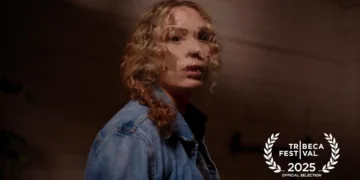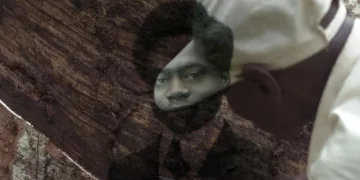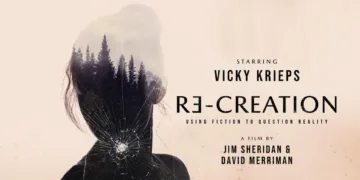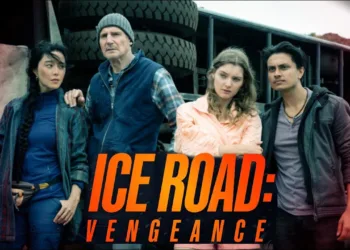There’s a specific, dusty smell to an old box of tapes that sends me right back to my childhood bedroom, meticulously recording movies off the television. That feeling of holding a physical piece of media, a tangible record of a moment, feels almost alien today.
Man Finds Tape taps directly into that feeling. It begins in the quiet Texas town of Larkin, where Lucas Page unearths a MiniDV tape from his past. The footage is simple yet chilling: an unknown man in his room as he slept, an event he has no memory of. He does what anyone might do in 2025: he starts a YouTube series.
His investigation goes viral, drawing the attention of his estranged sister, Lynn, a documentarian. She returns home, camera in tow, thinking she is there to pull her brother back from an online obsession. Instead, she finds herself at the center of a glitch in reality, where video evidence is solid but human memory is frighteningly fluid. The film sets its hook not with a monster, but with a deeply modern question: what happens when seeing is no longer believing?
Assembling Truth from Static
The way a story is told is often the story itself, and Man Finds Tape elevates this idea into its central artistic statement. This is not your standard shaky-cam affair. Directors Paul Gandersman and Peter Hall construct their film like a complex piece of evidence, a mosaic of different media formats whose textures are as important as their content.
We get the polished, well-lit talking heads of Lynn’s documentary, where the audio is crisp and the framing is stable, providing a clean narrative spine. This is constantly interrupted by the raw, artifact-heavy feed from Lucas’s web series, the frantic handheld footage mirroring his agitated state of mind.
The editing is key, cutting sharply between these sources and other media—screen-captured Reddit threads, security footage, even old, degraded VHS recordings of a local church’s public access show. The sound design follows suit, shifting from clear dialogue to the distorted hum and ambient noise of old tech.
This layering mimics the experience of falling down an internet rabbit hole, of trying to assemble a coherent belief from scattered, untrustworthy sources. It’s a hallmark of ambitious independent cinema, where budget constraints force a creativity that mainstream productions often iron out. A standout sequence involving a car crash, seen only from the perspective of a dropped smartphone, relies entirely on audio to build its terror, a brilliant solution that showcases a deep understanding of the format.
The Ghosts in the Machine
At its heart, the film is a detective story where the clues are memories and the crime scene is an entire town. The mystery expands beautifully from Lucas’s single tape to a town-wide affliction, a strange phenomenon causing residents to have blackouts and shared amnesia.
The central engine of the narrative is the sibling relationship, which feels authentic in its friction. Lynn is the skeptical anchor, a documentarian professionally trained to seek objective facts. Lucas is the obsessive believer, a man desperate for validation in the face of the unexplainable.
Their dynamic, born from a shared family trauma surrounding their parents’ deaths, evolves as the proof becomes too strange to dismiss. Their investigation introduces us to the citizens of Larkin, each a vital piece of the puzzle. Reverend Endicott Carr is a particularly effective character, an intimidating preacher whose authority represents the town’s established order, an order threatened by Lucas’s revelations.
Then there is the cryptic figure known only as “The Stranger,” a man whose appearances on camera cause the footage itself to warp, a literal ghost in the machine. Yet, it’s the testimony of Wendy Parker, Lucas’s ex-girlfriend, that gives the supernatural events a human cost, grounding the high-concept ideas in palpable fear and loss.
The Horror of Not Knowing
The scariest things are the ones we can’t quite see or, even worse, the ones we are made to forget. Man Finds Tape generates its chills not from things that jump out of the dark, but from a creeping, psychological dread that settles in your bones. Its true horror is the idea of an unseen force that can edit your reality, plucking memories from your mind like a video editor deleting a scene.
This connects directly to our deepest contemporary anxieties about the “post-truth” era. In a world of deepfakes and rampant misinformation, the film’s monster is not a creature with claws, but an entity that makes you doubt your own sanity. It’s a potent metaphor for gaslighting on a societal scale. This places the film in a more philosophical, almost Lovecraftian, tradition.
The terror is cosmic, stemming from the realization of how fragile our perception of the universe is, a dread brought to a small Texas town via a YouTube channel. The film doesn’t tie up every loose end, a brave choice that respects the audience. It leaves you with the quiet, unnerving hum of uncertainty, a feeling that is hard to shake in an age where the line between the real and the artificial grows blurrier every day.
Man Finds Tape premiered at the Tribeca Film Festival after being shot around a fictional small Texas town.
Full Credits
Directors: Paul Gandersman, Peter S. Hall
Writers: Paul Gandersman, Peter S. Hall
Producers and Executive Producers: Kristen Bell
Cast: John Gholson, Christine V. Hall, Nell Kessler, William Magnusen
Editors: Paul Gandersman
The Review
Man Finds Tape
A chillingly intelligent and timely horror film, Man Finds Tape transcends its found-footage roots to become a potent commentary on truth and memory in our fractured digital age. Its clever construction and psychological depth are more terrifying than any jump scare, leaving a lasting impression long after the static fades. A must-see for fans of smart, atmospheric horror that gets under your skin.
PROS
- An intelligent script that builds a genuinely compelling mystery.
- Innovative use of a hybrid media format that enhances its themes.
- Generates exceptional psychological dread and atmospheric tension.
- Culturally relevant ideas that tap into modern anxieties about truth.
CONS
- The deliberate, slow-burn pacing may not appeal to all horror fans.
- Its ambiguous ending might leave some viewers wanting more closure.
- The central sibling relationship, while effective, could have been explored with even greater depth.















































